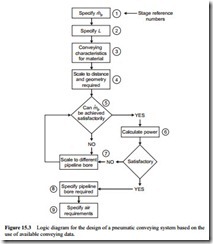The use of test data in system design
The application and use of test data is probably the most common method of designing a pneumatic conveying system. This is used extensively in cases where test data or pre- vious experience with a material is available. Where no previous experience with a particular material is available, it is usual to obtain test data specifically for the purpose of system design, since the use of mathematical models is particularly unreliable in these situations. As for the section on the use of equations in system design, two logic dia- grams are also presented here, one for the original design of a system, and another for evaluating the capability of an existing system.
Related posts:
Case studies:Variable speed drives on water pumps supplying a ring main at a domestic appliance fact...
Benefits, drawbacks and operational issues:Low base speed motors
Gas–solid separation devices:Separation requirements and Separation mechanisms.
Operating problems:Vacuum nozzles and Flow control.
Review of pneumatic conveying systems:Closed systems
Introduction to pneumatic conveying and the guide:Information provided ,Availability of design data ...
Conveying characteristics:Energy considerations and The influence of conveying air velocity.
Conveying characteristics:Conveying characteristics and Conveying mode.
Control components in a hydraulic system:Shock absorbers
Pneumatic controllers.
Process Control Pneumatics:Pneumatic controllers
Safety, Fault-Finding and Maintenance:fault-finding Instruments
BASICCONCEPTS OF THE RMODYNAMICS:THE MANOMETER
SUMMARY OF BASICCONCEPTS OF THE RMODYNAMICS
HEAT EXCHANGERS:ANALYSIS OF HEAT EXCHANGERS
